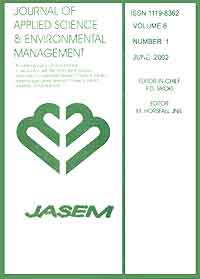
|
Journal of Applied Sciences and Environmental Management
World Bank assisted National Agricultural Research Project (NARP) - University of Port Harcourt
ISSN: 1119-8362
Vol. 22, No. 5, 2018, pp. 707-711
|
 Bioline Code: ja18121
Bioline Code: ja18121
Full paper language: English
Document type: Research Article
Document available free of charge
|
|
|
Journal of Applied Sciences and Environmental Management, Vol. 22, No. 5, 2018, pp. 707-711
| en |
Adsorption and Biodegradation of 1-Methyl Naphthalene Using Immobilized Pseudomonas macerans  and Bacillus subtilis and Bacillus subtilis  on Burnt Kaolin on Burnt Kaolin
IBRAHIM, SS; GIMBA, CE; OMONIYI, KI & NWOKEM, NC
Abstract
This work is aimed at assessing the effect of incorporating Pseudomonas macerans and Bacillus
subtilis on burnt kaolin (BK) during the biodegradation of 1-methyl naphthalene. The biodegradation was monitored
by determining the concentration of CO2 released. Immobilized Pseudomonas macerans on BK released CO2 in the
range of 0.72 - 0.83 mg/L, while this was 0.68 - 0.78 mg/L with Bacillus subtilis; for the degradation alone the range
was 0.39 - 0.46 mg/L after 72 h. Generally, the concentration of carbon (IV) oxide released by the immobilized
Pseudomonas macerans was more than that by Bacillus subtilis. Therefore, immobilization using BK resulted to better
removal of the organic pollutant. The FTIR indicated presence of new peaks within the regions 3272-3265cm-1 and
1647-1640cm-1 attributed to overlapping of hydroxyl (-OH) and carbonyl (C=O) stretching in carboxylic acid. The
absorptions within 1114-1088 cm-1, and at 1408cm-1 are due to C-O stretching and O-H in plane bending of carboxylic
acid respectively. The use of kaolin for environmental clean-up of organic pollutants will enhance the value chain of
solid minerals in Nigeria.
Keywords
Burnt kaolin; degradation; organic pollutant; clean-up
|
| |
© Copyright 2018 - Ibrahim et al.
|
|
